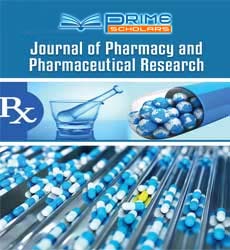Short Communication - (2023) Volume 7, Issue 3
Pioneering Healthcare: The Revolution of Novel Drug Delivery Systems
Steven Maur*
Department of Pharmacy, Aristotle University of Thessaloniki, Greece
*Correspondence:
Steven Maur,
Department of Pharmacy, Aristotle University of Thessaloniki,
Greece,
Email:
Received: 29-Aug-2023, Manuscript No. IPIPR-23-18170 ;
Editor assigned: 31-Aug-2023, Pre QC No. IPIPR-23-18170 (PQ);
Reviewed: 14-Sep-2023, QC No. IPIPR-23-18170;
Revised: 19-Sep-2023, Manuscript No. IPIPR-23-18170 (R);
Published:
26-Sep-2023, DOI: 10.21767/ipipr.7.03.030
Introduction
The world of medicine is undergoing a significant transformation
with the development of novel drug delivery systems. These cutting-
edge technologies are redefining the way medications are
administered, offering enhanced precision, improved patient outcomes,
and reduced side effects. In this article, we explore the
concept of novel drug delivery systems, their various forms, and
their potential to reshape the future of healthcare. Conventional
methods of drug delivery, such as oral tablets or injections, have
long been the standard in medicine. However, these methods
come with limitations, often resulting in suboptimal therapeutic
outcomes and sometimes severe side effects. Novel drug delivery
systems aim to overcome these challenges by offering more targeted,
efficient, and patient-friendly approaches.
Description
Nanotechnology is revolutionizing drug delivery by manipulating
particles at the nanoscale. Nanoparticles loaded with medications
can target specific cells or tissues, increasing drug efficacy and reducing
systemic side effects. This approach is particularly promising
for cancer treatments, where precision is critical. Implantable
devices offer a long-term, sustained release of medications. These
devices can be placed under the skin or within the body, ensuring
a consistent and controlled drug delivery over an extended period.
They are beneficial for conditions that require continuous therapy,
such as diabetes or chronic pain management. Inhaled drug delivery
systems are gaining popularity, especially for respiratory conditions.
Inhalers and nebulizers provide direct access to the lungs,
offering rapid and efficient relief. Additionally, inhalation therapies
can minimize the systemic distribution of drugs, reducing side effects.
Transdermal patches and creams have made steady progress
in recent years. They offer a non-invasive way to administer medications
through the skin, ensuring a controlled release. Transdermal
delivery is commonly used for hormone replacement therapy,
pain management, and nicotine replacement. Novel drug delivery
systems play a pivotal role in gene and RNA-based therapies. Lipid
nanoparticles and viral vectors are used to transport genetic material
into cells, offering hope for the treatment of genetic disorders
and certain diseases like COVID-19.
Convenient and painless delivery methods, such as transdermal
patches or inhalers, improve patient compliance, ensuring consistent
treatment. Implantable and nanotechnology-based systems
can provide long-term, sustained drug release, reducing the need
for frequent dosing. Despite their promise, novel drug delivery
systems face several challenges, including regulatory approval,
cost-effectiveness, and the need for further research and development.
Additionally, personalized medicine, where treatments are
tailored to individual genetic profiles, is an exciting frontier that
could be significantly advanced through novel delivery methods.
Conclusion
Novel drug delivery systems allow medications to target specific
cells, tissues, or organs, increasing treatment precision and efficacy.
By minimizing systemic exposure, these systems reduce the risk
of side effects and toxicity commonly associated with traditional
drug delivery methods. In conclusion, novel drug delivery systems
are at the forefront of medical innovation. They hold the potential
to optimize therapeutic outcomes while minimizing side effects,
offering hope for more effective and patient-friendly treatments.
As these technologies continue to evolve and become more accessible,
the future of healthcare looks increasingly promising, with
novel drug delivery systems paving the way for a new era of precision
medicine.
Acknowledgement
The author is grateful to the journal editor and the anonymous
reviewers for their helpful comments and suggestions.
Conflict Of Interest
The author declared no potential conflicts of interest for the research,
authorship, and/or publication of this article.
References
- Pachuau L (2015) Recent developments in novel drug delivery systems for wound healing. Expert Opin Drug Deliv 12(12):1895-909.
[Crossref] [Google Scholar] [PubMed]
- Gao H (2018) Novel nanoparticles for tumor targeting drug delivery Curr Drug Metab 19(9):722.
[Crossref] [Google Scholar] [PubMed]
- Ejeta F (2022) Recent formulation advances and preparation of orally disintegrating tablets. Int J Pharm Compd 26(5):370-377.
[Crossref] [Google Scholar] [PubMed]
- Agrahari V (2018) Novel drug delivery systems, devices, and fabrication methods. J Pharm Pharmacol 8(2):303-306.
[Crossref] [Google Scholar] [PubMed]
Citation: Maur S (2023) Pioneering Healthcare: The Revolution of Novel Drug Delivery Systems. J Pharm Pharm Res. 7:030
Copyright: © 2023 Maur S. This is an open-access article distributed under the terms of the Creative Commons Attribution License, which permits unrestricted use, distribution, and reproduction in any medium, provided the original author and source are credited.

